Guyer - An Introduction to Roofing and Painting
Here you can read online Guyer - An Introduction to Roofing and Painting full text of the book (entire story) in english for free. Download pdf and epub, get meaning, cover and reviews about this ebook. year: 2015, genre: Romance novel. Description of the work, (preface) as well as reviews are available. Best literature library LitArk.com created for fans of good reading and offers a wide selection of genres:
Romance novel
Science fiction
Adventure
Detective
Science
History
Home and family
Prose
Art
Politics
Computer
Non-fiction
Religion
Business
Children
Humor
Choose a favorite category and find really read worthwhile books. Enjoy immersion in the world of imagination, feel the emotions of the characters or learn something new for yourself, make an fascinating discovery.
- Book:An Introduction to Roofing and Painting
- Author:
- Genre:
- Year:2015
- Rating:5 / 5
- Favourites:Add to favourites
- Your mark:
- 100
- 1
- 2
- 3
- 4
- 5
An Introduction to Roofing and Painting: summary, description and annotation
We offer to read an annotation, description, summary or preface (depends on what the author of the book "An Introduction to Roofing and Painting" wrote himself). If you haven't found the necessary information about the book — write in the comments, we will try to find it.
Guyer: author's other books
Who wrote An Introduction to Roofing and Painting? Find out the surname, the name of the author of the book and a list of all author's works by series.
An Introduction to Roofing and Painting — read online for free the complete book (whole text) full work
Below is the text of the book, divided by pages. System saving the place of the last page read, allows you to conveniently read the book "An Introduction to Roofing and Painting" online for free, without having to search again every time where you left off. Put a bookmark, and you can go to the page where you finished reading at any time.
Font size:
Interval:
Bookmark:
An Introduction to
Roofing and Painting
J. Paul Guyer, P.E., R.A.
Editor

The Clubhouse Press
El Macero, California
CHAPTERS
Chapter Page
1. ROOFING SYSTEMS 1
2. COATINGS AND PAINTS 52
3. ANALYSIS OF PAINT FAILURES 101
4. INSPECTION OF PAINTINGOPERATIONS 124
(This publication is adapted from the UnifiedFacilities Criteria of the United States government which are in the publicdomain, have been authorized for unlimited distribution, and are notcopyrighted.)
(Figures, tables and formulas in this publication mayat times be a little difficult to read, but they are the best available. DONOT PURCHASE THIS PUBLICATION IF THIS LIMITATION IS UNACCEPTABLE TO YOU.)
CHAPTER 1
ROOFING SYSTEMS
1. STARTINGPOINTS FOR ROOF SYSTEM SELECTION. This Chapter is intended to introduce themajor considerations in selecting a roofing system. Figure 1 depicts thevarious alternative roofing systems and how they relate. When commencing theselection process there are two different starting points.
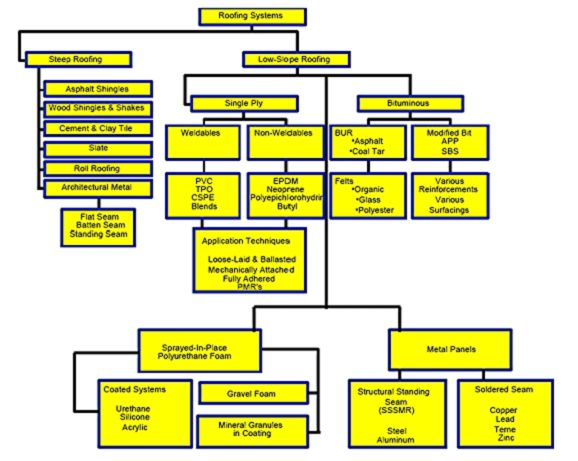
Material and Roofing System Options
Figure 1
1.1 New vs.Reroofing. The roof may be part of a new building design; or, it mayinvolve the reroofing of an existing structure (replacement or re-cover).Today, approximately 75% of roofing activity is reroofing.
1.2 Steep-Slopevs. Low-Slope. In new construction the designer is very likely to have a preconceivednotion as to whether a highly visible sloped-roof is wanted, or whethera less visible low-slope roof design is acceptable. Positive drainage isa very important design criterion. When reroofing, it may be feasible toimprove drainage by using tapered insulation or sloped deck fills.
2. SELECTIONCONSIDERATIONS FOR STEEP ROOFING SYSTEMS. Table 1 evaluates common steeproofing systems based upon some use criteria.
2.1 Aesthetics.Steep roof systems make a strong visible statement about a building. The texture,shadow-line, and color are major factors in selection.
2.2 MinimumSlope Requirements. Steep roofs function by shedding water rather than by beingwaterproof (Figure 2). Minimum slopes as shown in Table 13, are required in orderto insure proper drainage.
2.3 Categoriesof Steep Roofing. Major categories of steep roofing include asphaltshingles, wood shingles and shakes, tile, slate, architectural metal, asphaltroll roofing, and fabricated units of metal or plastic intended to look likethe others. Only asphalt roll roofing and asphalt or wood shingles may bere-covered.
2.4 Snowsheddingand Ventilation. Sloped roofs are effective snowshedders. In addition, theattic space that accompanies steep roofing makes it easy to ventilate theroofing system.
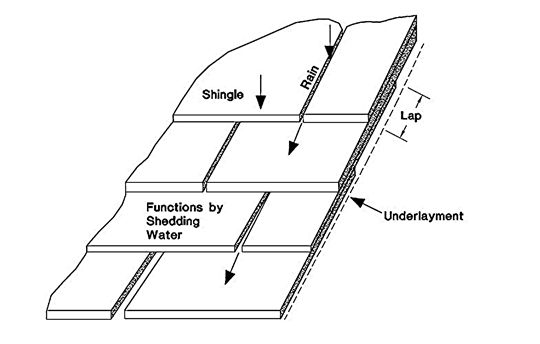
Steep Roofing (hydrokinetic)
Figure 2
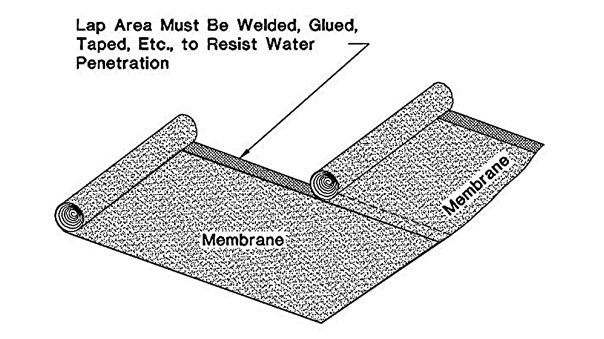
Low-Slope (hydrostatic)
Figure 3
2.5 MaintenanceRequirements. Sloped roofs in general, require less maintenance than flat roofingsystems.
2.6 SteepRoof Conversions. When considering reroofing a flat roof, it may bepossible to convert the low-slope roofing system to a steeply sloped roof. Thismay improve the appearance of the building while resolving drainage problems aswell. Steep roof conversions are a viable option for relatively narrowbuildings.
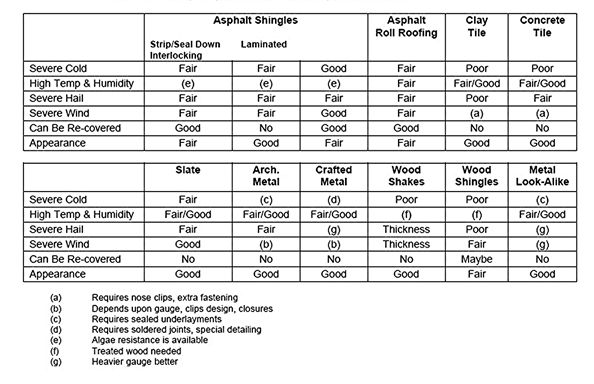
Steep Slope Selection Based Upon Use Criteria
Table 1
3. SELECTIONCONSIDERATIONS FOR LOW-SLOPE (MEMBRANE) ROOFING.
Membraneroofing is typically used on commercial buildings where the minimum slopesrequired by steep roofing render them impractical for larger buildings.Low-slope membrane systems are completely sealed at laps and flashings (Figure 3)and can temporarily resist standing water conditions. Choices for membraneroofing include multi-ply bituminous built-up (BUR), polymer-modified bituminous(MB), elastomeric single-ply systems (e.g., EPDM), thermoplastic single-ply systems(e.g., PVC or TPO), sprayed-in-place polyurethane foam (SPF), and some metal (hydrostatic/low-slope/SSSMR)systems. Designers frequently select low-slope roofs when the roof is expectedto accommodate rooftop equipment. With the exception of foam and metal, all low-slopesystems can be incorporated into Protected Membrane Roof (PMR) designs.
4. REROOFINGAND RE-COVERING.
4.1 Reroofing.The term replacement is used when the existing roofing system is to beeither partially or totally removed and a new system installed. The designershould consider any existing problems and whether drainage and thermalperformance needs to be improved. Existing surfaces such as walls and curbsmay be contaminated with bitumen, which might affect compatibility with somereroofing options. Additional concerns (as compared to new roofing) includewhether the existing structure can handle a significantly heavier roof systemand whether construction activities of the reroof system will affect theoccupants of the building (i.e., fumes, falling debris, and noise).
4.2 Re-cover.The term re-cover is used when a new roofing system is to besuperimposed directly over an existing system. In this case, underlyingconditions are obscured making assessment of their condition more difficult.Additional concerns include how the re-cover system will be attached to theexisting membrane or roof deck, and compatibility with the substrate. The potentialfor trapped water between the old and new membrane may suggest the use ofventing base sheets and/or roof vents.
5. ENVIRONMENTALISSUES. A relatively new design criterion is whether the roof system underconsideration meets green criteria, such as whether the systemincorporates postconsumer waste or is itself recyclable at the end of itsuseful life. Roof system waste is bulky and puts a great strain on wastedisposal sites. Energy efficiency is also important in terms of raw materialsacquired, production of finished goods, and application of the roof system.Thermal performance in service and retention of thermal value with age areequally important. A sustainable or robust roof is highlydesirable as extension of the life of the roof contributes to overallconservation. High albedo (reflective) roofs may improve localized climateconditions. The felt used in asphalt organic shingles consists primarily ofrecycled wastepaper, wood chips, and sawdust. Asphalt itself is a by-product ofpetroleum refining. Wood fiber and perlite roof insulation contain waste paper.Glass fiber and asphalt organic shingles have been recycled into asphaltcurbing and the like. Wood shingles and shakes can be recycled into gardenmulch. Steel and aluminum contain recycled scrap and at the end of their life,metal panels can be recycled back into scrap. Tables 2 and 3 compareenvironmental considerations for steep and low-slope roofing systems.
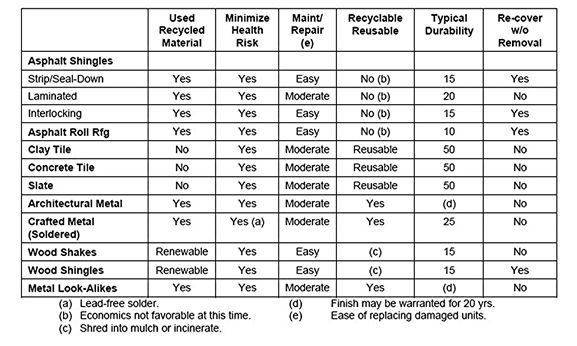
Font size:
Interval:
Bookmark:
Similar books «An Introduction to Roofing and Painting»
Look at similar books to An Introduction to Roofing and Painting. We have selected literature similar in name and meaning in the hope of providing readers with more options to find new, interesting, not yet read works.
Discussion, reviews of the book An Introduction to Roofing and Painting and just readers' own opinions. Leave your comments, write what you think about the work, its meaning or the main characters. Specify what exactly you liked and what you didn't like, and why you think so.











